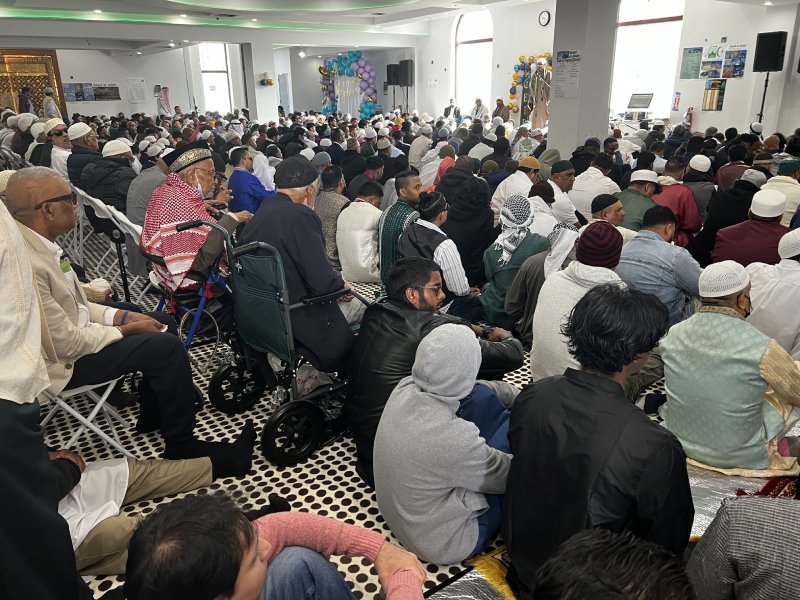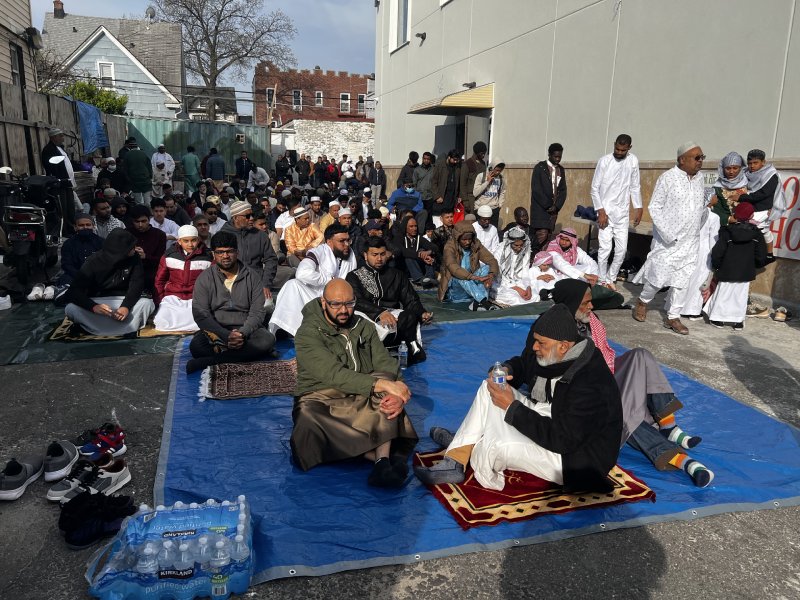Eid Ul Fitr was celebrated on Wednesday, April 10 by many Guyanese, Trinidadian, and other Muslims in New York and other parts of the USA with traditional morning prayers (salaat) at Masjids across the city and around the country. There are a dozen Guyanese and Trinidadian masjids in New York (most in Queens, Brooklyn, and Bronx) where prayers were held nightly for the monthly long breaking of the fast. Eid culminated the month-long dawn-to-dusk fasting period of Rojah or Ramadan, also called Ramzan, that commenced on March 10.
Eid is among the most important days for Muslims. Masjids were beautifully dressed with green party favors and colorful flickering lights. Many Guyanese homes were also brilliantly decorated outdoors and indoors reflecting the symbol of the Eid festival of a Crescent moon that was sighted Tuesday night to mark the end of the fast.

Tens of thousands of Guyanese and Trini Muslims have settled in the New York metro area since the 1960s; most are in Queens with large numbers also in Orlando, Miami, and Ft. Lauderdale where they also established masjids. The dozen Indo-Guyanese Masjids in the greater Richmond Hill area and several more in other parts of Queens, Brooklyn, and the Bronx to cater the spiritual needs of the large Guyanese and Trinidadian community in the New York environs.
Eid was greeted by bright sunshine and warm temperatures as worshippers gathered inside masjids with throngs flowing outdoors. Roads were shut off with police barricades to accommodate celebrants for prayers and the morning breaking of the fast. Parking was suspended in New York for the holiday. Public schools were also closed.
The festival morning began with prayers from the Holy Koran uttered by a lead Muezzin, Imam or ‘Meiji’ as is known in Guyana. Attendees overflowed from inside the Masjid Al Abidin on 126 Street and Liberty Ave and the Jama Masjid on 102 Street and 95th Ave. onto the sidewalks of streets. The males gathered inside on the first floor and basement of Al Abidin flowing outside while females gathered on the upper floor and in a nearby building on 126th Street. At Jama Masjid, males gathered outside of the Jama Masjid while females were indoors. Many Guyanese worshippers were dressed in brilliantly colored traditional Indian garb while some were attired in full Arabesque and Yemeni tradition with long gowns including headgear worn by Arabs in Arabia.
Islam was transplanted from Guyana and Trinidad to New York by early migrants during the late 1960s when the USA opened its borders in 1965 to non-White nationalities. Muslims of varied nationalities began coming to America. Guyanese and Trinidadians cooperated in promoting and institutionalizing their version of Islam. Guyanese and each nationality and Islamic sect established their own ‘jamaat’ and Masjid that have been patronized by their own followers. For Wednesday’s Eid celebrations, several Blacks from Africa attired in their national dress joined Guyanese and Trinis in ‘mangay’, ‘doa’, and supplication.
Following the salaat or prayers, worshippers gave alms. Worshippers gave zakat or donations in separate boxes on a table for the masjid, imams or Meiji, muezzin, and Charities. Worshippers also gave donations or alms to the less fortunate who were on the sidewalks.
At the conclusion of prayers, worshippers embraced and uttered “Eid Mubarak”, shook hands and or embraced each other, exchanged other greetings, and or shared gifts.
Worshippers partook in snacks such as sawai or vermicelli (liquid and cake), pastries, dates, mithai, gulab jamun, and other sweets. At Jama Masjid, an ice cream truck was hired to provide gratis ice cream to the congregation.
During the month of Ramadan, politicians hosted Iftaar get-togethers for the breaking of the fast. On Tuesday, politicians conveyed Eid greetings to the Muslim community.
